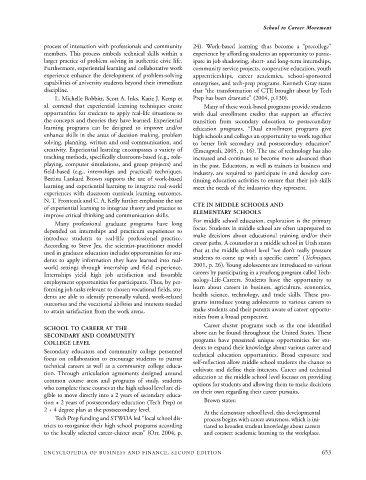Page 676 - Encyclopedia of Business and Finance
P. 676
eobf_S 7/5/06 3:21 PM Page 653
School to Career Movement
process of interaction with professionals and community 24). Work-based learning thus become a “precollege”
members. This process embeds technical skills within a experience by affording students an opportunity to partic-
larger practice of problem solving in authentic civic life. ipate in job shadowing, short- and long-term internships,
Furthermore, experiential learning and collaborative work community service projects, cooperative education, youth
experience enhance the development of problem-solving apprenticeships, career academies, school-sponsored
capabilities of university students beyond their immediate enterprises, and tech-prep programs. Kenneth Gray states
discipline. that “the transformation of CTE brought about by Tech
L. Michelle Bobbitt, Scott A. Inks, Katie J. Kemp et Prep has been dramatic” (2004, p.130).
al. contend that experiential learning techniques create Many of these work-based programs provide students
opportunities for students to apply real-life situations to with dual enrollment credits that support an effective
the concepts and theories they have learned. Experiential transition from secondary education to postsecondary
learning programs can be designed to improve and/or education programs. “Dual enrollment programs give
enhance skills in the areas of decision making, problem high schools and colleges an opportunity to work together
solving, planning, written and oral communication, and to better link secondary and postsecondary education”
creativity. Experiential learning encompasses a variety of (Emeagwali, 2005, p. 16). The use of technology has also
teaching methods, specifically classroom-based (e.g., role- increased and continues to become more advanced than
playing, computer simulations, and group projects) and in the past. Educators, as well as trainers in business and
field-based (e.g., internships and practical) techniques. industry, are required to participate in and develop con-
Bettina Lankard Brown supports the use of work-based tinuing education activities to ensure that their job skills
learning and experiential learning to integrate real-world meet the needs of the industries they represent.
experiences with classroom curricula learning outcomes.
N. T. Frontczak and C. A. Kelly further emphasize the use
CTE IN MIDDLE SCHOOLS AND
of experiential learning to integrate theory and practice to
ELEMENTARY SCHOOLS
improve critical thinking and communication skills.
For middle school education, exploration is the primary
Many professional graduate programs have long
focus. Students in middle school are often unprepared to
depended on internships and practicum experiences to
introduce students to real-life professional practice. make decisions about educational training and/or their
According to Steve Jex, the scientist-practitioner model career paths. A counselor at a middle school in Utah states
that at the middle school level “we don’t really pressure
used in graduate education includes opportunities for stu-
students to come up with a specific career” (Techniques,
dents to apply information they have learned into real-
2001, p. 26). Young adolescents are introduced to various
world settings through internship and field experience.
Internships yield high job satisfaction and favorable careers by participating in a yearlong program called Tech-
employment opportunities for participants. Thus, by per- nology-Life-Careers. Students have the opportunity to
forming job tasks relevant to chosen vocational fields, stu- learn about careers in business, agriculture, economics,
dents are able to identify personally valued, work-related health science, technology, and trade skills. These pro-
outcomes and the vocational abilities and interests needed grams introduce young adolescents to various careers to
to attain satisfaction from the work arena. make students and their parents aware of career opportu-
nities from a broad perspective.
Career cluster programs such as the one identified
SCHOOL TO CAREER AT THE
above can be found throughout the United States. These
SECONDARY AND COMMUNITY
programs have presented unique opportunities for stu-
COLLEGE LEVEL
dents to expand their knowledge about various career and
Secondary educators and community college personnel technical education opportunities. Broad exposure and
focus on collaboration to encourage students to pursue self-reflection allow middle school students the chance to
technical careers as well as a community college educa- cultivate and define their interests. Career and technical
tion. Through articulation agreements designed around
education at the middle school level focuses on providing
common course areas and programs of study, students
options for students and allowing them to make decisions
who complete these courses at the high school level are eli-
on their own regarding their career pursuits.
gible to move directly into a 2 years of secondary educa-
tion + 2 years of postsecondary education (Tech Prep) or Brown states:
2 + 4 degree plan at the postsecondary level.
At the elementary school level, this developmental
Tech Prep funding and STWOA led “local school dis- process begins with career awareness, which is ini-
tricts to reorganize their high school programs according tiated to broaden student knowledge about careers
to the locally selected career-cluster areas” (Orr, 2004, p. and connect academic learning to the workplace.
ENCYCLOPEDIA OF BUSINESS AND FINANCE, SECOND EDITION 653

